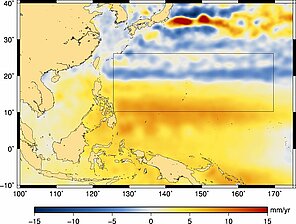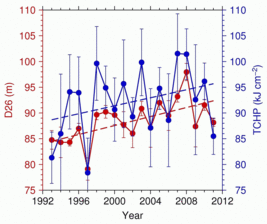20 years of altimetry for typhoons
Image of the Month - August 2013


Tropical cyclones are known to be intensified by the heat of the upper ocean. The North-West Pacific is the most active area on earth for tropical cyclone (typhoon) formation and intensification, and one of the most densely populated coastal regions, thus making typhoon forecasting vital information for billions of people.
Sea surface heights from altimetry contain the variability of the whole column of water, thus enabling to have an insight on ocean subsurface processes. Combining altimetry with sea surface temperature (SST) and gravimetry (to compute sea level anomalies due only to thermohaline effects) measurements leads to estimates of the subsurface warm layer thickness (typically represented by the depth of the 26 °C isotherm) and upper ocean heat content (often referred to as TCHP, Tropical Cyclonic Heat Potential). With twenty years of altimetry available, the variability of those factors of cyclone intensification can be studied. This shows that, although the SSTs in the western North Pacific Main Development Region of cyclones (10–26°N, 122–170°E) have varied little over the last two decades, the subsurface conditions have become more favorable for typhoon and super-typhoon intensification. The consequences on the intensity of typhoons are still to be assessed in conjunction with other atmospheric environmental factors.
The long-term continuity in altimetry measurements is a major asset in cyclone intensification studies. Research has been lead in the 1990's, that are now leading to operational information and long-term studies both. With the new Saral mission, and the future Jason-3, altimetry measurements will be continued in the coming years, thus enabling to reach a 30 years (climatological) time series.
See also:
- Applications: Marine meteorology and atmospheric studies
- Applications: Hurricane Katrina intensification
- Newsletter Aviso : Using satellite altimetry to identify regions of hurricane intensification, G. Goni et al., Aviso Newsletter 9
Websites on this subject:
References:
- Pun, I.-F., Lin I.-I., and Lo M.-H., 2013. Recent Increase in High Tropical Cyclone Heat Potential Area in the Western North Pacific Ocean, Geophys. Res. Lett. (accepted)




